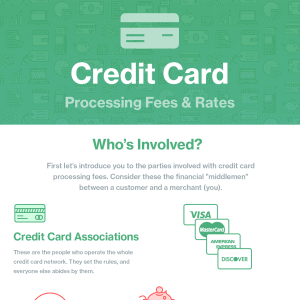How does third-party credit card processing work? Learn what these providers do, their benefits, and the risks small businesses should consider.
Our content reflects the editorial opinions of our experts. While our site makes money through
referral partnerships, we only partner with companies that meet our standards for quality, as outlined in our independent
rating and scoring system.
Third-party payment processors are one of the easiest ways for small or first-time business owners to start accepting credit and debit cards.
Also called payment service providers (PSPs), these companies let you sign up online, skip the paperwork of a traditional merchant account, and start taking payments almost instantly.
In this guide, we’ll break down how third-party processors work, their pros and cons, and how they compare to full-service merchant accounts so you can decide which is right for your business.
What Is A Third-Party Payment Processor?
A third-party payment processor lets you accept cards without setting up your own merchant account. Instead, you share one large merchant account with other businesses.
For your customers, nothing changes — they still pay with their card like normal. But for you, this setup usually results in flat-rate pricing, fewer fees, and no long-term contracts.
How Does Third-Party Processing Work?
The basics of how payments move don’t really change. Your customer pays with a card, the processor runs the transaction through the networks, and you get the money in your bank account (minus fees).
The big difference is in the account setup. With a third-party processor, you’re part of a shared merchant account. With a traditional provider, you’d get your own Merchant ID tied just to your business.
For a small business, that distinction may not matter much at first. But as you process more transactions, having your own merchant account typically brings more stability and can even save you money over time.
Who Offers Third-Party Payment Processing?
While there aren’t as many third-party processors as traditional providers, the big names are widely recognized by both merchants and customers:
Popular Third-Party Processors
Other Business Software With Built-In Processing
Not Third-Party Processors (Digital Wallets Only)
Why Are Third-Party Payment Processors Popular?
There are three reasons why third-party processing is so popular:
- Fast approval: Sign up online and get approved in hours, not weeks.
- Simple pricing: Flat rates with no hidden fees.
- Flexibility: No long-term contracts or termination penalties.
For many small businesses, simplicity and predictability matter more than chasing the absolute lowest rate.
Third-Party Processors VS Merchant Accounts
To make it easier, let’s stack third-party processors up against merchant accounts and see how they compare.
| Feature |
Third-Party Processors |
Merchant Accounts |
| Account Structure |
Aggregated with other users |
Unique merchant ID |
| Approval Process |
Typically less than 24 hours |
Several days to two weeks |
| Commitment |
Month-to-month; no contracts |
Varies; may require long-term contracts |
| Pricing |
Flat-rate; fully disclosed |
Tiered, interchange-plus, or membership |
| Account Fees |
Usually none for a basic account |
May have monthly/annual fees |
| Processing Limits |
Limits are fixed and can’t be negotiated |
May be able to negotiate limits |
| Account Stability |
Higher risk of holds, freezes, termination |
More stable after underwriting |
| Customer Support |
Often limited |
More robust (varies by provider) |
| Best For |
<$5K monthly volume |
>$5K monthly volume |
There’s no clear winner. What works for a startup may not fit a growing business, and vice versa.
Advantages Of Using A Third-Party Payment Processor
Here’s a look at the benefits of using a third-party payment processor for your business:
- Quick setup: Sign up and start processing in hours.
- Low startup costs: Card readers are cheaper than traditional POS systems.
- No monthly fees: Pay only when you process payments.
- Flat-rate pricing: Easy to predict processing costs.
- No contracts: Cancel anytime without penalties.
- Tech-forward platforms: Strong apps, integrations, and modern features.
Disadvantages Of Using A Third-Party Payment Processor
Third-party processors also come with some limitations:
- Account stability: Higher chance of sudden holds or freezes.
- Unclear processing limits: Volume or transaction size can trigger issues.
- Limited card acceptance: Some processors don’t support specialized cards (e.g., EBT).
- Hardware/software lock-in: You may be limited to the processor’s own tools.
- Higher per-transaction costs: Flat rates are pricier than interchange-plus for larger businesses.
- Customer service gaps: Support is often limited to online help centers.
Risk Considerations For Third-Party Payment Processing
Any card processor can freeze or terminate your account, but the risk is greater with third-party providers since you skip full underwriting.
Here’s how to reduce that risk:
- Be honest about your business and products.
- Stay PCI compliant.
- Manage chargebacks and fraud proactively.
- Have a backup payment option ready (like Venmo or Zelle).
For most low-risk, small businesses, freezes are rare but still worth planning for.
Is A Third-Party Payment Processor Right For My Business?
Some third-party processors are among the best for small businesses, especially those processing under about $5,000/month. They’re affordable, simple, and flexible.
Larger or more established businesses usually save money (and headaches) with a traditional merchant account. Cutoffs vary — some say $1,500/month, others $10,000/month — but $5K/month is a good general guideline.
When deciding, ask yourself:
- Is my business year-round or seasonal?
- How much will I process monthly?
- Do I need specialized tools like POS or advanced reporting?
- Is my business in a high-risk category?
Bottom line: Third-party processors are great for getting started, but most growing businesses eventually outgrow them and move to a full-service merchant account.











